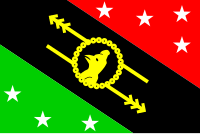Southern Highlands Province
| Southern Highlands | |
|---|---|

|
|
| geography | |
| Country: | Papua New Guinea |
| Waters: | |
| Islands: | ( located in New Guinea ) |
| Geographical location: | 6 ° 10 ′ S , 143 ° 20 ′ E |
| Basic data | |
| Surface: | 15,089 km² |
| Residents: | 515,511 |
| Population density: | 34 inhabitants / km² |
| Capital: | Mendi |
| Situation map | |
Southern Highlands ( Tok Pisin : Sauten Hailans ) is one of the 21 provinces of Papua New Guinea . The province has an area of 15,089 km² and 515,511 inhabitants (as of 2010). The capital is Mendi with 17,119 inhabitants.
The Southern Highlands is rich in limestone mountains with huge caves , many of which are still unexplored. In addition to the mountains, wide valleys and river landscapes dominate. The Highlands Highway leads as a dirt road to the capital Mendi, but the province is not yet very well developed for tourism. Otherwise economic development in the Southern Highlands is very poor.
Southern Highlands belonged south of the main ridge of the Central Mountains to the Australian colony Territory of Papua and not to German New Guinea like the other mountain provinces. An expedition did not penetrate the area until 1935, and the Australian administration had great difficulty with the hostile population until the end of the colonial period.
Since May 17, 2012, the Komo Magarima , Koroba-Lake Kopiago and Tari-Pori districts , which previously belonged to the Southern Highlands Province, form the new Hela Province .
The neighboring provinces are Gulf in the southeast, Hela, Enga , Western Highlands and Jiwaka in the north and Western in the southwest.
population
The Huli belong to the larger tribes. The Mendi live around the capital and fence their traditional one-family gardens. Smaller tribes are the Foi and the Fasu , which can be recognized by their headdress made of cockatoo feathers. The Kaluli are gardeners in the tropical rainforest who are considered great storytellers. During their Gisa festival, they sing sad ballads from past events and burn severe burns to themselves in their emotional pain with torches. Later they are very proud of the burn scars.
Districts and LLGs
The Southern Highlands Province is divided into five districts. Each district consists of one or more "areas at the local administrative level", Local Level Government (LLG) Areas , which are divided into Rural (rural) or Urban (urban) LLGs.
| District | Administrative center | Designation of the LLG areas |
|---|---|---|
| Ialibu-Pangia District | Ialibu | East Pangia Rural |
| Ialibu Urban | ||
| Kewabi Rural | ||
| Wiru Rural | ||
| Imbonggu District | Imbonggu | Ialibu Basin Rural |
| Imbongu Rural | ||
| Lower Mendi Rural | ||
| Kagua-Erave District | Kagua | Erave Rural |
| Kagua Rural | ||
| Kuare Rural | ||
| Mendi-Munihu District | Mendi | Karint's Rural |
| Lai Valley Rural | ||
| Mendi Urban | ||
| Upper Mendi Rural | ||
| Nipa-Kutubu District | Nipa | Lake Kutubu Rural |
| Mount Bosavi Rural | ||
| Nembi Plateau Rural | ||
| Nipa Rural | ||
| Poroma Rural |
Web links
literature
- Heiner Wesemann: Papua New Guinea. Niugini. Stone Age Cultures on the Way to the 20th Century. DuMont, Cologne 1985, ISBN 3-7701-1322-5 ( DuMont culture travel guide in the series DuMont documents ).
Individual evidence
- ↑ National Research Institute of Papua New Guinea: Southern Highlands Province ( Memento of the original from July 22, 2013 on WebCite ) Info: The archive link was inserted automatically and has not yet been checked. Please check the original and archive link according to the instructions and then remove this notice. (PDF file; 216 kB)
- ↑ Gorethy Kenneth: Population of PNG is more than 7 million. Post-Courier Online, April 4, 2012 ( Memento of the original from July 13, 2012 in the Internet Archive ) Info: The archive link was automatically inserted and not yet checked. Please check the original and archive link according to the instructions and then remove this notice. Retrieved September 14, 2012
- ^ National Statistical Office of Papua New Guinea
